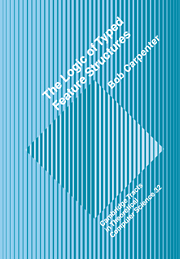 The Logic of Typed Feature Structures
The Logic of Typed Feature Structures Published online by Cambridge University Press: 12 October 2009
In our development up to this point, we have treated feature structures logically as models of descriptions expressed in a simple attribute-value language. In the last chapter, we extended the notion of description to include variables; in this chapter, we generalize the notion of model to partial algebraic structures. An algebraic model consists of an arbitrary collection of domain objects and associates each feature with a unary partial function over this domain. In the research of Smolka (1988, 1989) and Johnson (1986, 1987, 1990), more general algebraic models of attribute-value descriptions are the focus of attention. We pull the rabbit out of the hat when we show that our old notion of satisfaction as a relation between feature structures and descriptions is really just a special case of a more general algebraic definition of satisfaction. The feature structures constitute an algebraic model in which the domain of the model is the collection of feature structures, and the features pick out their natural (partial) value mappings. What makes the feature structure model so appealing from a logical perspective is that it is canonical in the sense that descriptions are logically equivalent if and only if they are logically equivalent for the feature structure model. In this respect, the feature structure model plays the same logical role as term models play in universal algebra. This connection is strengthened in light of the most general satisfier and description theorems, which allow us to go back and forth between feature structures and their normal form descriptions.
To save this book to your Kindle, first ensure [email protected] is added to your Approved Personal Document E-mail List under your Personal Document Settings on the Manage Your Content and Devices page of your Amazon account. Then enter the ‘name’ part of your Kindle email address below. Find out more about saving to your Kindle.
Note you can select to save to either the @free.kindle.com or @kindle.com variations. ‘@free.kindle.com’ emails are free but can only be saved to your device when it is connected to wi-fi. ‘@kindle.com’ emails can be delivered even when you are not connected to wi-fi, but note that service fees apply.
Find out more about the Kindle Personal Document Service.
To save content items to your account, please confirm that you agree to abide by our usage policies. If this is the first time you use this feature, you will be asked to authorise Cambridge Core to connect with your account. Find out more about saving content to Dropbox.
To save content items to your account, please confirm that you agree to abide by our usage policies. If this is the first time you use this feature, you will be asked to authorise Cambridge Core to connect with your account. Find out more about saving content to Google Drive.